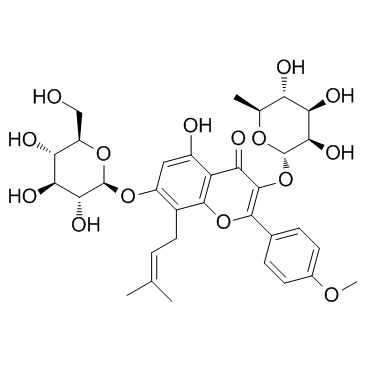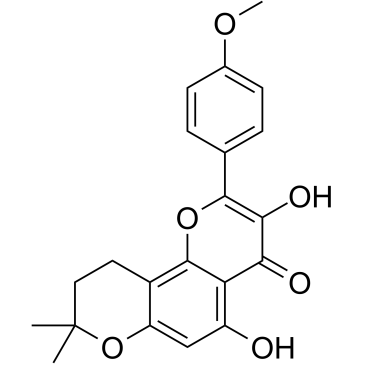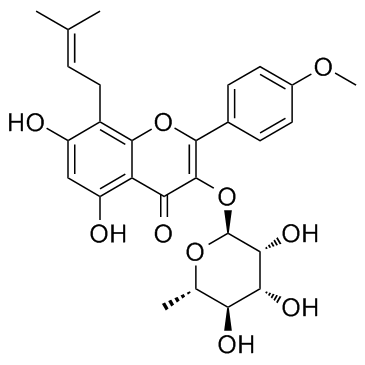Icariin

Icariin structure
|
Common Name | Icariin | ||
|---|---|---|---|---|
| CAS Number | 489-32-7 | Molecular Weight | 676.662 | |
| Density | 1.6±0.1 g/cm3 | Boiling Point | 948.5±65.0 °C at 760 mmHg | |
| Molecular Formula | C33H40O15 | Melting Point | 223-225ºC | |
| MSDS | Chinese USA | Flash Point | 300.9±27.8 °C | |
Use of IcariinIcariin is a flavonol glycoside. Icariin inhibits PDE5 and PDE4 activities with IC50s of 432 nM and 73.50 μM, respectively. Icariin also is a PPARα activator. |
| Name | Icariin |
|---|---|
| Synonym | More Synonyms |
| Description | Icariin is a flavonol glycoside. Icariin inhibits PDE5 and PDE4 activities with IC50s of 432 nM and 73.50 μM, respectively. Icariin also is a PPARα activator. |
|---|---|
| Related Catalog | |
| Target |
PDE5:432 nM (IC50) PDE4:73.5 μM (IC50) PPARα Autophagy |
| In Vitro | Icariin is a cGMP-specific PDE5 inhibitor. The inhibitory effects of Icariin on PDE5 and PDE4 activities are investigated by the two-step radioisotope procedure with 3H-cGMP/ 3H-cAMP. The potency of selectivity of Icariin on PDE5 (PDE4/PDE5 of IC50) is 167.67 times[1]. Cell viability is measured in the present study to evaluate whether Icariin protect endothelial HUVECs from injuries induced by oxidized low-density lipoprotein (ox-LDL). The exposure of the cells to ox-LDL for 24 h significantly decreases the cell viability compared with control group (P<0.05). However, Icariin can inhibit cell injury induced by ox-LDL in a concentration-dependent manner, and has significant difference (P<0.05) compared with ox-LDL-simulated group[3]. |
| In Vivo | Icariin is a PPARα activator, induces Cyp4a10 and Cyp4a14, and regulates the mRNA levels of lipid metabolism enzymes and proteins, including fatty acid binding protein, fatty acid oxidation in mitochondria and in peroxisome. Icariin is effective in the treatment of hyperlipidemia. To understand the effect of Icariin on lipid metabolism, effects of Icariin on PPARα and its target genes are investigated. Mice are treated orally with Icariin at doses of 0, 100, 200, and 400 mg/kg, or Clofibrate (500 mg/kg) for five days. Liver total RNA is isolated and the expressions of PPARα and lipid metabolism genes are examined. PPARα and its marker genes Cyp4a10 and Cyp4a14 are induced 2-4 fold by Icariin, and 4-8 fold by Clofibrate. The fatty acid (FA) binding and co-activator proteins Fabp1, Fabp4 and Acsl1 are increased 2-fold. The mRNAs of mitochondrial FA β-oxidation enzymes (Cpt1a, Acat1, Acad1 and Hmgcs2) are increased 2-3 fold. The mRNAs of proximal β-oxidation enzymes (Acox1, Ech1, and Ehhadh) are also increased by Icariin and Clofibrate. The expression of mRNAs for sterol regulatory element-binding factor-1 (Srebf1) and FA synthetase (Fasn) are unaltered by Icariin. The lipid lysis genes Lipe and Pnpla2 are increased by Icariin and Clofibrate[2]. Adult rats are treated orally with Icariin at doses of 0 (control), 50, 100, or 200 mg/kg body weight for 35 consecutive days. The results show that Icariin has virtually no effect on the body weight or organ coefficients of the testes or epididymides. However, 100 mg/kg Icariin significantly increases epididymal sperm counts. In addition, 50 and 100 mg/kg Icariin significantly increase testosterone levels. Furthermore, 100 mg/kg Icariin treatment also affects follicle stimulating hormone receptor (FSHR) and claudin-11 mRNA expression in Sertoli cells. Superoxide dismutase (SOD) activity and malondialdehyde (MDA) levels are measured in the testes; 50 and 100 mg/kg Icariin treatment improve antioxidative capacity, while 200 mg/kg Icariin treatment upregulates oxidative stress[4]. |
| Cell Assay | Human umbilical vein endothelial cells (HUVECs) in the logarithmic growth phase are seeded into 96-well plates at a density of 1×104 cells per well, then incubated for 24 hours at 37°C, 5% CO2. After pretreatment with indicated concentration of Icariin (0, 10, 20, 40 μM) for 24 hours, the cells are incubated with or without ox-LDL (100 μg/mL) for next 24 hours. After suction of the liquid in the wells, MTT solution is added to yield a final concentration of 0.5 mg/mL, and incubation is continued for 4 h at 37°C, 5% CO2. MTT solution is removed gently and 150 μL of DMSO is added to each well for 15 min incubation. The absorbance of each sample is measrured on a microplate reader at 490 nm as cell viability[3]. |
| Animal Admin | Mice[2] Adult 8-week old male C57BL/6 mice are acclimated for 1-week in a temperature- and humidity-controlled facility with a standard 12-h light schedule. Mice have free access to SPF-grade rodent chow and purified drinking water. Mice are treated with Icariin (100, 200, and 400 mg/kg) for 5 days. Clofibrate (CLO, 500 mg/kg, po for 5 days) is used as a positive control, for negative controls, mice are given 2% CMC (10 mL/kg). 24 h after the last dose, livers are collected for analysis. Rats[4] Forty adult male SD rats weighing 200-290 g (12-16 weeks old) are randomly assigned to groups (n=10 per group) according to their body weight. The rats receive daily intragastric administration of Icariin at 0 (control), 50, 100, or 200 mg/kg per day for 35 consecutive days. The animals are weighed weekly, and the treatments are adjusted accordingly. At the end of the Icariin treatment period, all rats are sacrificed; blood samples are subsequently collected for further analyses of testosterone levels. |
| References |
| Density | 1.6±0.1 g/cm3 |
|---|---|
| Boiling Point | 948.5±65.0 °C at 760 mmHg |
| Melting Point | 223-225ºC |
| Molecular Formula | C33H40O15 |
| Molecular Weight | 676.662 |
| Flash Point | 300.9±27.8 °C |
| Exact Mass | 676.236694 |
| PSA | 238.20000 |
| LogP | 2.48 |
| Vapour Pressure | 0.0±0.3 mmHg at 25°C |
| Index of Refraction | 1.679 |
| InChIKey | TZJALUIVHRYQQB-XLRXWWTNSA-N |
| SMILES | COc1ccc(-c2oc3c(CC=C(C)C)c(OC4OC(CO)C(O)C(O)C4O)cc(O)c3c(=O)c2OC2OC(C)C(O)C(O)C2O)cc1 |
| Hazard Codes | Xi |
|---|---|
| RIDADR | NONH for all modes of transport |
| HS Code | 2932999099 |
| Precursor 0 | |
|---|---|
| DownStream 3 | |
| HS Code | 2932999099 |
|---|---|
| Summary | 2932999099. other heterocyclic compounds with oxygen hetero-atom(s) only. VAT:17.0%. Tax rebate rate:13.0%. . MFN tariff:6.5%. General tariff:20.0% |
|
Icariin promotes histone acetylation and attenuates post-stroke cognitive impairment in the central cholinergic circuits of mice.
Neuroscience 236 , 281-8, (2013) Post-stroke dementia (PSD) is a common clinical disease and the central cholinergic circuits are important to cognitive function. Icariin (ICA), a flavonoid isolated from Herba Epimedii, was reported ... |
|
|
High-performance liquid chromatography-based multivariate analysis to predict the estrogenic activity of an Epimedium koreanum extract.
Biosci. Biotechnol. Biochem. 76(5) , 923-7, (2012) This study characterizes the correlation between the chemical fingerprint and estrogenic activity of an Epimedium koreanum extract. The estrogenic activity of 31 E. koreanum extract samples was evalua... |
|
|
Inhibitory effect of icariin on Ti-induced inflammatory osteoclastogenesis.
J. Surg. Res. 192(2) , 447-53, (2014) Wear particle-induced periprosthetic osteolysis that results in aseptic loosening is the most common cause of long-term failure after total joint replacement.Icariin (ICA), a flavonoid isolated from E... |
| ICARRIN |
| ICARIN |
| Icariin |
| Ieariline |
| Icariil |
| ICARIINE |
| Epimedim P.E |
| Icariln |
| Icraiin |
| 4'-O-methyl-8-γ,γ-dimethylallylkaempferol-3-rhamnoside-7-glucoside |
 CAS#:38226-86-7
CAS#:38226-86-7 CAS#:118525-40-9
CAS#:118525-40-9 CAS#:113558-15-9
CAS#:113558-15-9
